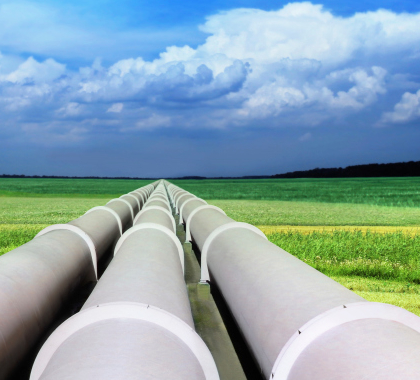At a press conference, President Donald Trump announced he had approved the final leg of the Keystone XL Pipeline, linking oil fields in Alberta, Canada to refineries on the Texas Gulf Coast.
Among those joining Trump in the Oval Office at the March 24 press conference were Energy Department Secretary Rick Perry; Russ Girling, president of TransCanada, the company that owns the pipeline; and Sean McGarvey, president of North America’s Building Trades Unions.
Trump’s approval came just two months after he signed an executive order reviving the Keystone XL and Dakota Access Pipelines. Both projects were stalled and then blocked by the Obama administration. With Trump’s approval, the Dakota Access Pipeline has already been completed. Now, subject to approval by the Nebraska Public Service Commission, construction on the final stage of the Keystone XL Pipeline can begin.
Thousands of Jobs
Upon completion, the $8 billion Keystone XL Pipeline would carry more than 830,000 barrels per day along its 1,200-mile route. The U.S. Department of State has estimated Keystone XL will create between 3,900 and 6,000 construction jobs and a total of 42,000 jobs indirectly related to the project. The pipeline would create 35 permanent monitoring and maintenance jobs upon completion.
At the press conference, Trump said approval of Keystone XL is part of the commitment he made as a candidate for president to increase infrastructure projects.
“As the Keystone XL Pipeline now moves forward, this is just the first of many energy and infrastructure projects that my administration will approve … in order to help put Americans back to work, grow our economy, and rebuild our nation,” Trump said. “The fact is that this $8 billion investment in American energy was delayed for so long, it demonstrates how our government has too often failed its citizens and companies over the past long period of time.
“Today, we begin to make things right and to do things right,” said Trump. “Today, we take one more step in putting the jobs, wages, and economic security of American citizens first.”
Long and Winding Road
The approval process for the Keystone XL Pipeline lasted nearly nine years, more than five times the average for pipeline applications.
TransCanada first proposed the project in 2008, late in President George W. Bush’s second term. President Barack Obama twice rejected the Keystone XL Pipeline.
After the State Department issued a report in August 2011 concluding Keystone XL would have “no significant impacts” on the environment or carbon-dioxide emissions, then-Secretary of State Hillary Clinton said she was “inclined” to approve the project. However, in January 2012, Obama rejected the proposal and sent it back to the State Department, which then required TransCanada to resubmit the proposal with suggested alternative routes.
On January 31, 2014, the State Department, under Secretary of State John Kerry, issued its final report, saying regardless of the route chosen, Keystone XL would not substantially worsen “carbon pollution” or do other harm the environment.
Congress Approved, Obama Vetoed
With Obama still not having decided whether to give final approval to Keystone XL by 2015, on January 29, 2015, the U.S. Senate passed a bill approving construction, by a vote of 62 in favor of the pipeline to 36 against. The U.S. House passed the bill by a vote of 270 to 152 on February 11, 2015. Obama vetoed the bill on February 24, 2015. The Senate failed to override the veto.
On November 16, 2015, two weeks before the U.N. Paris Climate Conference, Obama announced he was rejecting Keystone XL because it “would not serve the national interest of the United States … [because] we must transition to a clean energy economy.”
In a press statement, Obama said his rejection of Keystone XL represented strong U.S. leadership in the fight against climate change.
“America is now a global leader when it comes to taking serious action to fight climate change,” said Obama’s statement. “And frankly, approving [Keystone XL] would have undercut that global leadership.”
Approval ‘Long Overdue’
In reversing Obama’s rejection of Keystone XL, Trump embraced the State Department’s determination Keystone would create jobs without harming the environment.
Gary Stone, vice-president of engineering for Five States Energy, says Obama’s delay and eventual denial of approval were unjustifiable.
“The approval of the Keystone XL Pipeline was long overdue,” said Stone. “The Obama administration’s environmental excuse was nonsensical, considering the huge spider web of pipelines that populate the country from the Canadian border to the Gulf Coast refineries.
“The Keystone and the Dakota Access Pipelines should transport sufficient volumes to reduce the large historical crude [oil] pricing differential in the Williston Basin,” Stone said. “Pipelines also reduce the amount of crude transported by higher-risk and higher-cost rail cars.”
Political Fallout
Merrill Matthews Jr., a resident scholar of the Institute for Policy Innovation, said Obama’s vacillation on Keystone XL may have contributed to Trump’s election victory.
“President Obama delayed, and then unsurprisingly denied, approval of the Keystone XL pipeline for purely political reasons,” said Matthews. “He delayed the decision in order to insulate Democrats running in red-leaning states, and he rejected it to cement his legacy as the greenest president yet.
“However, his equivocating angered several unions whose members would have benefited from laying the pipeline,” Matthews said. “The sense that Democrats cared more about the environmental movement than middle-class jobs may have cost them several purple or blue-leaning states.”
Matthews says Trump’s early actions are creating jobs.
“Through his own efforts, President Trump has been able to point to thousands of jobs saved or created, lifting the mood of the country,” said Matthews. “He will now be able to add Keystone and the State Department’s estimated 3,900 direct construction jobs and 42,000 indirect jobs to that list.”
H. Sterling Burnett, Ph.D. ([email protected]) is a research fellow at The Heartland Institute.





